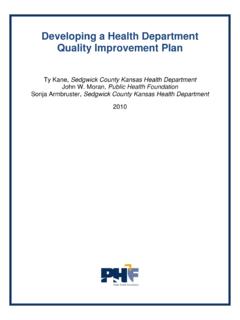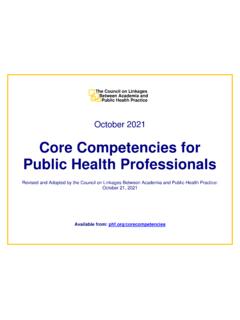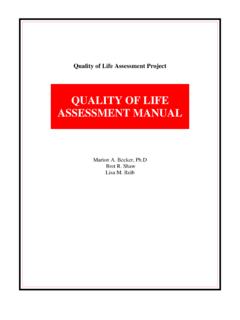Transcription of Evaluating Program Effectiveness: Planning Guide
1 Evaluating Program effectiveness : Planning Guide National Reporting System (NRS) Support Project Regional Training, 2018 Contents Introduction .. 1 Purpose of This Guide .. 1 Purpose of the 2018 NRS Regional Training .. 1 Why We Evaluate Program effectiveness .. 1 Planning Guide 3 Part I: Getting Started: Define the Purpose and Scope of the Evaluation .. 3 Part II: Design Your Evaluation: Using a Logic Model and Identifying Data .. 7 Part III: Procedural Plan: Collection and Analysis .. 21 Part IV: Defining effectiveness : Setting the Standards and Incentives .. 25 Part V: Using the Results: Close the Loop .. 31 Evaluating Program effectiveness : Planning Guide 1 Purpose of This Guide This Planning Guide is a tool for participants of the 2018 National Reporting System (NRS) Regional Training.
2 As a participant, you will use this Guide to deepen your understanding of training content and apply information learned at the workshop to develop and implement a state evaluation system. The Guide describes each step in the process of developing or revising an evaluation system, offers examples, and provides a template for your state team to draft your own evaluation plan. The completed Planning Guide will serve as the main reference document for your team in Planning or revising your state evaluation system after the training ends. Purpose of the 2018 NRS Regional Training At the training, your state team will develop or improve a system for Evaluating local Program performance to identify areas in need of improvement and improve overall state performance.
3 To develop an evaluation system, your state team will: Explore the purposes and approaches to evaluation. Identify state priorities that define effective performance. Select data elements and approaches to collecting data for the evaluation. Determine how to use evaluation data to improve state performance. Develop a plan for a statewide performance evaluation system. Why We Evaluate Program effectiveness There are several reasons to use a state evaluation system for Evaluating Program effectiveness . The evaluation may help a state identify and focus on (1) areas of concern at the local level, (2) performance and policy implementation issues, or (3) areas for continuous Program improvement. Along with the face-to-face training, this Guide will help your state think through the process of establishing or revising an evaluation system.
4 An evaluation system should be an ongoing process to evaluate a specific programmatic change. You probably do some kind of Program evaluation already. If so, you can use the approach we offer to identify areas you might strengthen or redesign. If you do not currently conduct evaluation activities or want to improve your current process, our approach provides guidance on the areas to examine and steps to take. Although there are several other ways to plan and conduct an evaluation, below are five main elements to include as you develop or revise your system. This Guide will address each element. 1. Define the purpose and scope of the evaluation. 2. Design the evaluation. 3. Develop a data collection and analysis plan. 4. Collect and analyze the data. 5. Use the results and close the loop.
5 Introduction Evaluating Program effectiveness : Planning Guide 3 Part I: Getting Started: Define the Purpose and Scope of the Evaluation Before you begin creating or revising your evaluation system, you need to determine what you want to know and why you want to know it. What do you hope to learn from your Program evaluation? Begin with establishing the purpose of your evaluation. An evaluation system will have several topics and goals and may include examining: The types and numbers of participants; The services offered by the Program , including instruction and supportive services; and The outcomes that participants achieve. Keep in mind that you will want your evaluation to be responsive to performance and policy issues. As such, your evaluation may focus on multiple topics and change over time to reflect the implementation of your improvement strategies.
6 The following table provides examples of possible topics that address your participants, services, and outcomes. Participants Services Outcomes Appropriate target population Participant coverage from all areas of the state or Program regions Sufficient demographic and literacy-level diversity Identify gaps Who is missing? Meet recruitment goals Services match participant needs Right services to right participants Sufficient intensity and duration Gaps in services Types of classes Job training Integrated Education and Training Support service needs Meeting targets on indicators Measurable skill gains (MSG), employment, and credentials Types of MSGs achieved Educational Functioning Levels (EFLs) and secondary credential targets Pre-/post-test gains EFL gains Sufficient posttesting Planning Guide Sections Evaluating Program effectiveness : Planning Guide 4 In selecting your topic or topics that you will focus your evaluation on, consider what you want to know about each.
7 The following questions may spark some ideas: Are we including the appropriate population of learners? Are we addressing the needs of learners across the entire state and regions? Is there sufficient demographic and literacy-level diversity among our participants? What are the gaps in participation ( , Who are we missing? And are we meeting our recruitment goals?)? Do our programs offer adequate diversity of programming to meet the needs of our learners, in terms of content, logistics, and other factors? Are classes offered of sufficient intensity and duration to support our students to reach their goals? Are we meeting our targets for measurable skill gains (MSG), employment, and credentials? Where are we failing to meet our targets? Are programs providing the right assessments at the right time for all students?
8 Evaluating Program effectiveness : Planning Guide 5 Activity: Determining Your State s Topic, Goal, and Scope Your first step is to identify the topic or topics your evaluation will address as well as the intended goal and scope for your evaluation. Step 1: Identify your topic(s) Think about your local programs in terms of participants, services, and outcomes. Note the highest priority concerns you have, starting with the two to three topics that your evaluation system may examine. _____ _____ _____ Step 2: Identify issues and goals For each topic identified in Step 1, describe the issue or problem and the goal of the evaluation activity in the appropriate column in the following table. Topic Issue/Problem Goal Scope 1. 2. 3. Step 3: Establish the scope for each topic Based on Step 2, identify whether your evaluation will cover all or a subset of participants, services, or outcomes for each topic.
9 Add this information in the table above in the column labeled Scope. Evaluating Program effectiveness : Planning Guide 7 Part II: Design Your Evaluation: Using a Logic Model and Identifying Data Evaluation logic models are used to plan evaluation and the flow of activities in your evaluation system. Logic models are powerful tools for understanding the relationship between activities, resources, and outcomes. Logic models have many uses Program design, management, and evaluation are most common. There are many ways to organize a logic model and they can be very complex. Different models emphasize different components depending on their purpose. However, all approaches have the same underlying concepts. Using a Logic Model A completed logic model is a visual representation showing how activities affect outcomes in a logical sequence.
10 Logic models consist of the following sections: Topic and goals: What you are Evaluating and what you want to accomplish Inputs ( Program resources): What the Program has. Examples include: Teachers, staff, and funding to address the topic Outputs (activities and audience): What the Program does with its inputs and who participates in activities. Examples include: Training, webinars, and written resources for administrators, teachers, and students Outcomes (short term, intermediate, and long term): Results of activities, changes, and impact, immediately and in the future. Examples include: Short term skills development and learning gains Intermediate obtain secondary diploma, enter postsecondary education, or get a job Long term gain credentials, complete college, or enter a career path with competitive wages Assumptions and external factors: Assumptions are ideas and beliefs you think are true that affect the outcomes.





